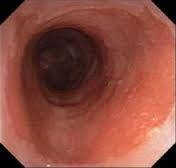Barrett esophagus is a potentially pre-cancerous condition typically appearing in the area where the lower part of the esophagus joins the stomach.
A normal, healthy stomach has an intense pinkish color, like smoked salmon or lox, while the esophageal lining has a grayish-white color. Generally, the pink stomach lining begins where the grayish-white esophagus ends. However, when there is severe acid injury to the bottom portion of the esophagus, the stomach lining starts to creep up into the esophagus, resulting in finger-like projections of pinkish tissue jutting into the grayish-white esophageal lining.
Barrett esophagus, or the presence of stomach tissue in the esophagus, is a dangerous sign for patients. It places that individual at a higher risk of developing esophageal cancer. In fact, those with Barrett esophagus are 30 to 125 times more likely to develop esophageal adenocarcinoma than the general population.
Barrett esophagus currently affects roughly 1% of adults in the United States. Men typically develop Barrett twice as often as women, and it is most common in white males over 50. However, over the past 10 years, I have been seeing men and women in their 40’s, 30’s, and even some in their 20’s with this condition. In the past 6 months alone I diagnosed Barrett in 3 people under the age of 28 (24, 26, and 28) all of whom had chronic hoarseness, but without heartburn.
About 8% of patients with Heartburn Reflux (GERD) have Barrett esophagus. Ominously, up to 10-15% of Throatburn Reflux (LPR) patients, those who have no heartburn but do have chronic symptoms of cough, hoarseness, lump-like sensation in throat, and throat clearing, have Barrett esophagus. By “chronic symptoms” I’m referring to symptoms lasting longer than eight weeks.
The unfortunate reality regarding esophageal cancer is that most people are at an advanced stage of the disease at the time they are diagnosed, with the survival rate usually being less than one year. The only way to make a dent in this disease is to catch it before it starts, and that is while it is still in its pre-cancerous, Barrett esophagus stage.
However, the current paradigm for examining patients for esophageal cancer dictates that essentially only people who complain of heartburn should be examined for Barrett esophagus. Yet this approach is ineffective in preventing the cancer since the majority of people with Barrett esophagus don’t experience heartburn due to the numbness of the esophageal tissue caused by acid damage over the years. Studies have shown that people who have Throatburn reflux symptoms are at higher risk of developing esophageal adenocarcinoma (the type of esophageal cancer caused by acid reflux damage) so that SYMPTOMATIC group is who should definitely be examined.


